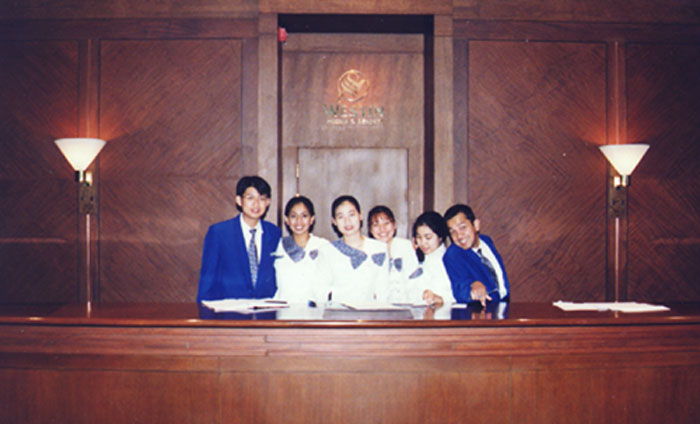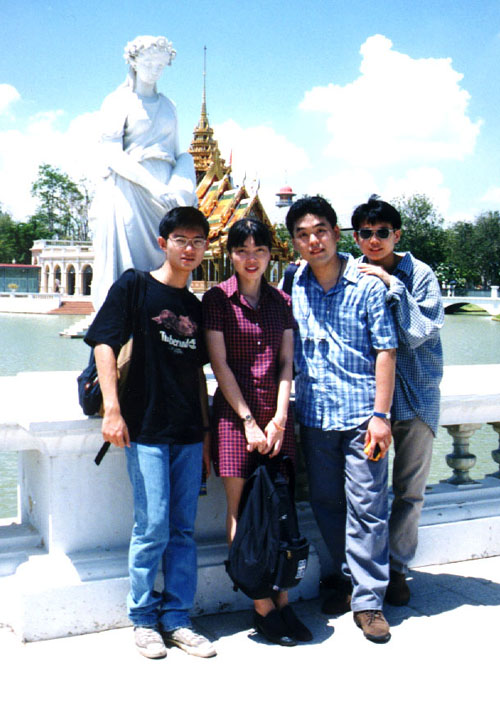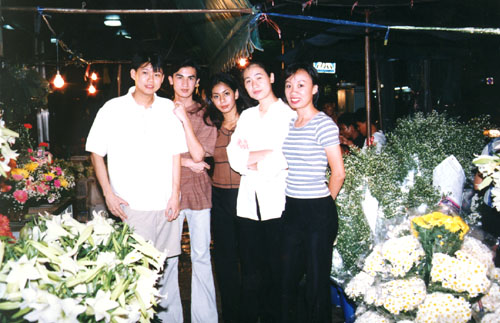 |
|
|
 |
|
|
The Westin Banyan Tree, Bangkok is a five-star hotel that caters mostly to business travellers. It is the tallest hotel in Bangkok and is the only one with all suite-rooms. Three NTU students were posted to this hotel for our PA. I was a management trainee and spent two months learning the operations of the Front Office. I was on shift duty and under the direct supervision of the most amiable managers one can ever imagine. At the end of the attachment, I was assigned a project which was to statistically analyse data of a questionnaire.
Before going to Bangkok, I used to have the impression that Bangkok is a congested, filthy, sex-polluted place. My impression has been tarnished by news reports of horrific traffic jams, pollution, immoral standards, rampant venereal diseases and even political unrest! Well, I’m glad the two- month attachment has helped me to dispel some of these undesirable impressions.
Yes, there are still terrible traffic jams, but as long as you avoid the peak hours, you’re fine! I was once in a taxi on the way home from the Grand Palace on a weekday at 6pm; the taxi hardly moved a metre for an hour! But after one and a quarter hours, the traffic suddenly cleared.
Being in Bangkok opened my eyes to the charms of this city. I love Bangkok at night. The city never seems to sleep; everywhere people are buzzing around with different activities. If you have been to Bangkok, places like Siam Square, Silom Rd (Patpong) and Sukhimvit Rd should ring a bell. Most of the big departmental stores, restaurants, night-markets, discos and pubs are situated in these areas. My favourite hangouts are Planet Hollywood, the Erawan Shrine, World Trade Centre and Sogo area.
Indeed,
I felt I was very lucky to have been acquainted with the friendliest Thais
around. We were in the same age-group and we had no problems relating to
each other. In fact, we have become very good friends in this short duration
of two months! They seem to know which place was currently "happening"
and we never missed out any fun in Bangkok! Having them in our company
also meant that we need not bargain while shopping as the stallholders
would always give us "Thai price". They were the ones who brought us trainees
out after work almost every evening for supper, dancing and perhaps a drink.
 |
 |
| At
the Bang Pa In, Ayutthayu with other
WorkAsia students |
With my Thai colleagues at the Flower Market |
Another favourite was the Yaowarat, or Chinatown, which has stalls selling all kinds of Chinese cuisines. We really felt at home. What’s most reminiscent of home was that most of the stallholders even spoke to us in Teochew! We returned several times and devoured anything from Kwai Teow Teng to Siew Mai to Cheng Teng. On Sundays, we would usually go to Chatukchat Weekend which is the biggest market in Bangkok. This huge compound is very organised and has stalls that sell almost anything you’re looking for: jeans, clothes, accessories, food, pets, groceries, souvenirs, etc. There must be more than 1000 stalls!
We travelled to the less cosmopolitan provinces like Kanchanaburi, Ayutthaya and Chonburi. The infamous River Kwei Bridge, which is in Kanchanaburi, forms part of the Death Railway from Thailand to Burma. The Japanese took about 100,000 lives (of POWs) just to build this bridge during the Second World War. Today it looks like any ordinary bridge.
Ayutthaya, which is situated in central Thailand, is one of the most gorgeous ancient cities in Thailand. Ayutthaya was one of the most prosperous cities a few centuries back. In fact, one still can catch a glimpse of the glory and magnificence of the city through the protected ruins. The Thai King’s summer palace, the Bang Pa In, is also in Ayutthaya Province. Indeed, this province is so charming that we went there twice on two consecutive weekends!
Chonburi is where Pattaya is situated. After years of tourists’ exploitation, the Pattaya City has lost much of its beauty to Phuket or Ko Samui in the south. Nevertheless, we stayed in Pattaya for a few days in one our colleague’s service apartment. The visit was well-worth it, and the payoff was rewarding with very fresh and affordable seafood.
In
general, my entire attachment was an eye-opener. I particularly enjoyed
learning Thai from my colleagues, making a mess of the 5 "unpronounceable"
Thai tones. I realised that most Thais are generally hospitable, friendly,
and sociable. The standard of living may not be as high as that in Singapore,
but the Thais definitely know how to enjoy life more than many Singaporeans
I know! If you are careful with certain formalities such as religion (ie.Buddhism)
and decorum (in terms of speech and behaviour), everything is fine! Remember
to keep an open mind and not expect anything to be like Singapore.